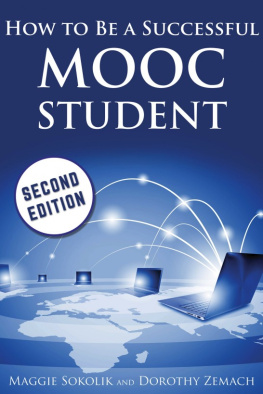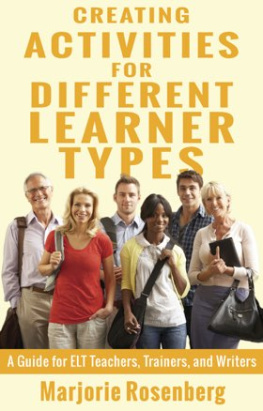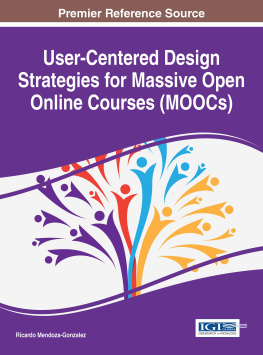How to Be a Successful MOOC Student
Copyright 2014 by Maggie Sokolik andDorothy Zemach
All rights reserved. No part of thispublication may be reproduced, stored in or introduced into aretrieval system, or transmitted, in any form, or by any means(electronic, mechanical, photocopying, recording, or otherwise)without the prior written permission of the copyright owner.Dramatic works contained within this volume are intended only asreading material, and their inclusion does not imply the grantingof performance licenses, which must be arranged through theauthor.
Edited by Dorothy E. Zemach. Cover design byDJ Rogers.
Published in the United States by WayzgoosePress.
Smashwords Edition, License Notes
This ebook is licensed for your personal enjoymentonly. This ebook may not be re-sold or given away to other people.If you would like to share this book with another person, pleasepurchase an additional copy for each recipient. If youre readingthis book and did not purchase it, or it was not purchased for youruse only, then please return to Smashwords.com and purchase yourown copy. Thank you for respecting the hard work of thisauthor.
How to Be a
Successful MOOC Student
_____________________________
Maggie Sokolik
and
Dorothy Zemach
_____________________________

Tableof Contents
Preface
Who We Are and Why We Wrote ThisBook

Greetings from Berkeley, California!
Im Maggie Sokolik, and Ive been interested inonline education since the early 1990s. Its exciting to see thechanges in educational technology over the past decades.
I have been a member of the UC Berkeley faculty andadministration since 1992, working primarily in College WritingPrograms. However, I also spent four years in the College ofEngineering directing the technical communication program, andworked with our graduate student instructors as an administrator inthe Graduate Division. Ive been lucky to have so many differentviews of student and university life.
When MOOCs first hit the scene, a colleague workingat the Voice of America started contacting me with the idea that Ishould do an English language MOOC. I was finally persuaded, the USDepartment of State became a co-sponsor, and UC BerkeleysPrinciples of Written English MOOC began in 2013. During thefirst year, over three 5-week sessions, we enrolled nearly 140,000students from about 80 countries. We were delighted, amazed, andoverwhelmed. We knew it would be a popular course, but we had noidea how popular it would be.
During this first year, we learned a lot about theprocess, but mostly about the wonderful students and what theywanted and needed from a MOOC. We also discovered that whileacademics around the world were busy conducting research andwriting books and articles about MOOCs, no one was writingbooks to guide students through this new educationalwonderland.
And thus, the idea for this book was born. DorothyZemach, my colleague, course assistant, editor and publisher (awoman with many hats!) and I have written this guide together,hoping that it will be helpful for students of current MOOCs andthose wanting to explore MOOCs in the future.
We hope youll join our MOOC, or any MOOC, andexperience the exciting new world of education.
~ ~ ~

Hi! Im Dorothy Zemach, from Eugene, Oregon, U.S.A.Ive been involved with education all my life first as an Englishlanguage teacher, for about 20 years, and now as a teacher trainerand a textbook author and editor. Im also the owner and senioreditor of Wayzgoose Press, a small independent publisher offiction, non-fiction, and educational materials including thisbook.
My first MOOC experience was with Maggie, when Iagreed to assist her with Principles of Written Communicationthrough edX. Ive also taught a class in publishing through WizIQ,and Ive done a number of educational webinars sponsored byMacmillan Education (who publish some of my textbooks; I think ofwebinars as one-day MOOCs).
While assisting and teaching online courses, Iquickly realized that there are no materials readily available tohelp students use this type of course. Ten years ago, no one hadtaken a MOOC (because they didnt exist; MOOCs only started in2011), and now they are everywhere. While talking with Maggie abouthow we could help our students be more efficient and successfullearners, we decided to write this book. We hope you find ituseful! If you have suggestions or comments for future editions,Im always happy to hear from students and teachers ateditor@wayzgoosepress.com.
Chapter 1: Introduction to MOOCs
You probably bought this book because you areinterested in becoming a MOOC student, have been one, or just wantto find out what this MOOC business is all about. Its important tonote, of course, that like all things technological, MOOCs, whooffers them, certification processes, etc., are changing all thetime. But the principles of being a good online student areindependent of the software or certification options.
In this chapter, well briefly explain what a MOOC isand how they work, covering these topics:
1. What is a MOOC?
2. Who offers MOOC classes?
3. What kinds of classes are offered?
4. Who are the teachers?
5. Who are the students?
6. What equipment do I need?
7. How do I register?
1. What is a MOOC?
MOOC stands for massive open online course.Lets look at each one of these things:
Massive: MOOCs usually have thousands, eventens of thousands of students.
Open: a MOOC does not restrict who can takethe course, and does not charge money to its participants.
Online: The course takes place via theInternet.
Course: A MOOC typically has a syllabus,assignments, scores, and deadlines. There is an instructor as wellas course assistants.
But not all MOOCs are the same.
Even though the letters of MOOC stand for thesespecific words, there are variations in MOOC courses with respectto all of these things. Not all MOOCs, for example, have tens ofthousands of students; some MOOCs charge for courses or verifiedcertificates; some courses are self-paced, while others have setassignment schedules.
Its important to think about what features of a MOOCwill be important for your individual situation. For example, ifyou have a very busy schedule and making deadlines for assignmentsmight be difficult, a self-paced MOOC might work better foryou.
2. Who offers MOOCs?
MOOCs are usually offered through universities incooperation with a particular software platform. Several MOOCsoftware platforms exist, but three of the most popular onesare:
Coursera.com
Udacity.com
edX.org
COURSERA
Coursera is a for-profit MOOCplatform that started at Stanford University. Its universitypartners include Brown University, Berklee College of Music, CalTech, University of Tokyo, and dozens more. Coursera offersverified certificates and shareable course records, so thatstudents can share their progress with anyone they choose.
UDACITY
Next page














